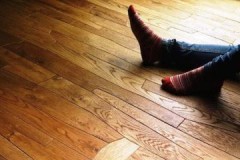So that a small problem does not become a big one - how to remove puffs on things
 Puffing is not only unpleasant, but also dangerous. If not removed, it can cause the threads to begin to unravel. As a result, the item will be hopelessly damaged.
Puffing is not only unpleasant, but also dangerous. If not removed, it can cause the threads to begin to unravel. As a result, the item will be hopelessly damaged.
What makes the situation worse is that it can appear on almost any product: tulle, curtains, jacket, sweater and more.
Read the article on how to remove the puff without damaging the item.
Content
What not to do?
 In order not to completely ruin the thing, You cannot do the following:
In order not to completely ruin the thing, You cannot do the following:
- You should not pull the fabric in different directions, trying to restore its integrity. This method of returning the loop to its place is dangerous because the entire weave may come apart.
- Do not try to cut or rip the thread. The tightening will continue.
- It is forbidden to wash a product with puffs. If the drum rotates vigorously, the damage will only worsen.
General rules
Any fabric is susceptible to tightening, but the fleecy and thinner the material, the more often this problem occurs. The loose weaving of the threads causes them to cling to different surfaces and “jump out” out.
There are two ways to remove a snag:
- bring the thread to the wrong side;
- press it into the fabric, releasing the tension on both sides.
There is also a third way to deal with puffs - stretching the material. However, it is not suitable for all products. Most often it is used when working with dense synthetic fabrics.
General rules to follow:
- Prepare the necessary tools in advance: a thin sewing needle, threads of a suitable color, a crochet hook.
- If the loops are small, it is better to use a magnifying glass.
- You should not try to remove the puff by weight. In this position there is a risk of breaking the thread. Once the integrity is damaged, it will not be possible to straighten it.
- You can finally put the thread in place if you go over the item with an iron or steamer.
Features of removal from different products
Pulls can appear on items made from different fabrics. Depending on its characteristics (strength, density of fibers, etc.), the features of their removal differ.
Knitwear
To get rid of tightness on knitwear, you will need a hook with a hook. This device is used for knitting. You will also need a needle and thread to match the item on which the puff appeared.
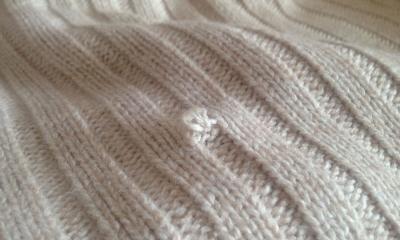 They operate in the following way:
They operate in the following way:
- use a hook to lift the puff;
- if a path has formed under it, it is smoothed out manually;
- straighten the thread to the wrong side of the item and tighten;
- so that it does not go further and does not turn outward, it is fixed using a thread and a needle.
The product is straightened, checking whether the damaged area is noticeable.
Tulle
If it is not difficult to remove the puff from most fabrics, it is enough to pull the thread to the wrong side, but it is not recommended to do this with tulle. Otherwise, a track will remain on it, which will spoil the entire appearance of the product.
You can restore tulle in the following way:
- Prepare a backlight in the form of a table lamp, a glass jar and a magnifying glass.
- Place the damaged area on the jar so that the tie is positioned above the neck.
- Secure the canvas so that it does not move. You can use a rubber band for this.
- Point the light source at the damage and hold the magnifying glass to it.
- Using the blunt end of a thin needle, pull the thread in the opposite direction, restoring the fabric pattern. The movement continues until the end of the track, to the very beginning of the puff.
You need to be guided by the pattern that is on the tulle. When the work is completed, the tulle is carefully ironed or passed over it with a steamer.
Trousers
 To remove a puff from your pants, you need to bring the thread that stretched the fabric to the wrong side, a little further from the hook itself.
To remove a puff from your pants, you need to bring the thread that stretched the fabric to the wrong side, a little further from the hook itself.
At the same time, the condition of the fabric on the front side of the trouser leg is monitored. There will be an accordion on it, which you don’t need to pay attention to for now.
When the thread is pulled together, grab the fabric with 4 fingers in the place where the thread was pulled to the wrong side. They begin to systematically straighten the fabric, stretching it in different directions..
This is done in order to straighten out the folds. In this way, it will be possible not only to prevent the fabric from spreading, but also to get rid of the visible defect.
Shorts
The drawstring on the shorts is removed using a sewing needle. Proceed as follows:
- straighten the product on a flat surface;
- To prevent the shorts from slipping, they can be secured with weights;
- insert a needle into the tightening area, but not all the way;
- a thread is threaded into the eyelet and pulled to the wrong side;
- if it is wide, you can grab it;
- the formed accordion is straightened.
So, in two minutes you can get your shorts in order.
Silk
To get rid of tension on silk fabric, proceed as follows:
- Lay out the fabric on a flat surface so that the puffs are at the top.
- At the site of the snag, the fabric is pierced with a needle, stopping its eye opposite the protruding thread.
- Thread the needle.
- Stretch it to the wrong side.
- Gently stretch the product and steam a section of the fabric.
There is no need to pull the thread that was brought to the wrong side.
Blouse or shirt
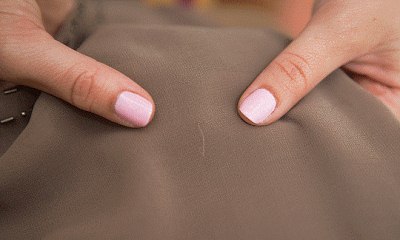 You can restore a blouse or shirt in the following way:
You can restore a blouse or shirt in the following way:
- stretch the product on the surface;
- shine a bright light on the thread;
- thread the thread into a thin needle;
- pull it out to the wrong side;
- straighten the fabric with a steam iron.
You need to work especially carefully with thin chiffon and silk shirts. Cotton items lend themselves better to correction.
Jeans
Pulls on denim rarely appear, as it is quite dense. If a snag does appear, it is hidden from the wrong side, since the fabric does not crawl.
Procedure:
- To work you will need a needle with a large eye.
- It is inserted next to the protruding thread so that only a slot remains on the surface.
- The thread is wetted and twisted to bring it together.
- Thread it through the eye of the needle and pull it out to the wrong side.
- Secure the thread with a basting.
Blazer
The puff on a jacket is removed according to the same principle as on other dense fabrics. The thread is threaded through the eye of the needle and brought out to the wrong side. The needle is selected to be of medium size.
Sometimes the work is complicated by the fact that the jacket has a lining. In this case, the lead is masked. The threads are matched to the tone of the product and the thread that comes out is stitched according to the warp and weft.
Sweater
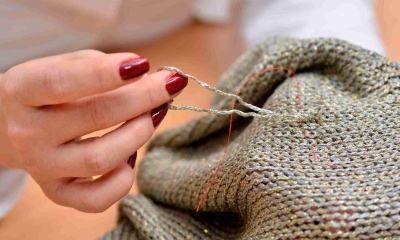 If a puff appears on a knitted sweater, it is better to correct it not with a needle, but with a crochet hook with a lock. Such devices are sold in yarn stores.
If a puff appears on a knitted sweater, it is better to correct it not with a needle, but with a crochet hook with a lock. Such devices are sold in yarn stores.
Using a hook, the thread is hooked and pulled back. When it is not too long, it can be left unchanged, or cut into two parts and tied at the ends.
Sometimes it happens that when tightening the loop comes down. In this case, you will need knitting skills. The work is done from the wrong side. Using a hook, lift the loops, hooking the thread in each row. When it comes to the last loop, it is fixed by carefully sewing it on.
Polyester
Dealing with polyester puffs is not difficult, since the material is synthetic. It has the strength of cotton, so it can be subjected to mechanical stress.
To deal with the tension, proceed as follows:
- lay the item out on a flat surface with the hook facing up;
- pinch the material with your fingers on two opposite sides;
- gently but persistently pulling him in different directions;
- if necessary, bring the thread to the wrong side.
After this procedure, all that remains is to smooth the product.
Dress
There is no universal way to deal with tightening on a dress. It all depends on what material it is made of.
Read more in this article.
Tights
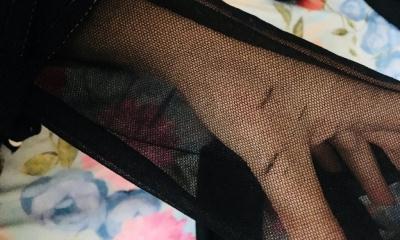 You can get rid of puffs on tights using the same principle as on thin fabrics: silk, chiffon and satin.
You can get rid of puffs on tights using the same principle as on thin fabrics: silk, chiffon and satin.
It is recommended to use not an ordinary sewing machine, but a surgical one, if, of course, one is available. If not, then looking for the thinnest needle in the house, but with a large eye.
If the loop is not lowered, it is carefully picked up and brought to the wrong side, after which it is secured with thread to the knot. Sometimes they use their own hair. Read more in this article.
How to prevent the occurrence of defects?
To prevent puffs from appearing, you need to adhere to the following recommendations:
- Items must be washed correctly, in accordance with the information on the label. Products made from delicate fabrics and large knitted items should not be put in the washing machine. The use of aggressive chemicals is unacceptable. By itself, it will not cause puffs to appear, but will cause the fabric to wear out faster.
- Wet clothes need to be wrung out and hung carefully, as they become more vulnerable to any impact.
- Products made from delicate fabric should be stored in a case. The looser the fabric, the higher the risk that puffs will appear on it even from contact with other things, for example, if accidentally touched by a brooch or rhinestones.
- You need to wash things with conditioner. It envelops the threads with a protective film, which prolongs their service life. The more lint and pellets, the higher the likelihood of puffs.
Helpful information
Tips for removing puffs from different things:
- to make it more convenient to work, use a thin needle, but with a large eye;
- you should not overstretch the fabric in an attempt to straighten it - failure to follow this recommendation may cause new snags to appear;
- You need to work in good lighting - if the room is dark, use a table lamp.
Video on the topic of the article
The video will show you how to remove a puff on delicate fabrics:
Conclusion
Almost every puff can be handled. The larger the thread, the easier it is to return it to its place. Working with delicate fabrics is more painstaking and requires more time. If you were unable to cope with the defect on your own, you can take the product to the studio.


